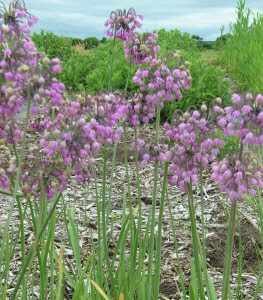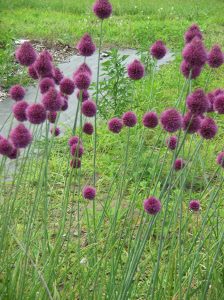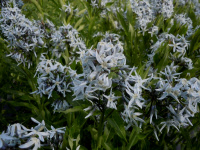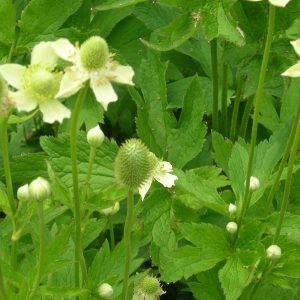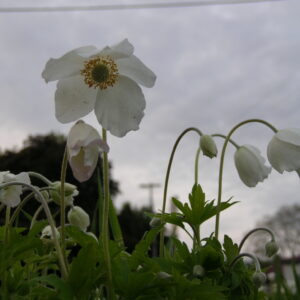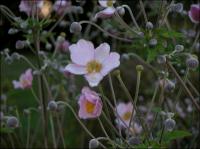Deer Resistant Plants
Showing 9–16 of 163 results
-
Allium cernuum Nodding onion, Prairie onion Z 4-8
Umbels of arching stems with nodding bells of lilac shading to pink or occasionally white. May to June.
Umbels of arching stems with nodding bells of lilac shading to pink or occasionally white. May to June.
We are very sorry, but due to state agricultural restrictions, we are not permitted to ship Allium bulbs to Idaho, or to the following five counties in the State of Washington: Adams, Benton, Franklin, Grant and Klickitat.
Size: 12”-18”x 3-6”
Care: sun to part shade in moist well-drained soil
Native: Canada to Mexico
Wildlife Value: nectar source for Hairstreak butterfly, Attracts hummingbirds. Alliums resist critters including deer, rabbits, squirrels, mice, and moles and voles. They cannot stand the onion-like smell of Alliums protecting near-by plants too.Cernuum is Latin meaning “nodding.” Many groups of 1st Americans ate the bulbs raw, roasted or dried for winter storage or as flavoring for soups and gravies. Cherokee used this plant medicinally to cure colds, hives, colic, “gravel & dropsy,” liver ailments, sore throats, “phthisic,” and feet in “nervous fever.” Those in the Isleta Pueblo were not quite as creative as the Cherokee and used this only for sore throats and infections. Meriwether Lewis collected this in Montana and wrote, “I met with great quantities of a small onion about the size of a musquit ball … They were crisp, white and well-flavoured. I gathered about a half a bushel of them before the crew arrivd.” Chicago is believed to be named for the Algonquin word for this plant chigagou.
-
Allium senescens Corkscrew allium, German garlic, Greater mountain garlic Z 4-9
Lavender balls, up to 30 of them, atop thin, bluish, strap-like, twisting foliage – mid-summer day’s dream.
Lavender balls, up to 30 of them, atop thin, bluish, strap-like, twisting foliage – mid-summer day’s dream.
We are very sorry, but due to state agricultural restrictions, we are not permitted to ship Allium bulbs to Idaho, or to the following five counties in the State of Washington: Adams, Benton, Franklin, Grant and Klickitat.
Size: 6-12” x 6-12”
Care: sun to part shade in well-drained to moist well-drained soil
Native: Siberia
Wildlife Value: Attracts butterflies & bees. Resists critters including deer, rabbits, squirrels, mice, and moles and voles. They cannot stand the onion-like smell of Alliums protecting near-by plants too.Cultivated before 1753. According to Philip Miller’s 1768 Dictionary, “planted in gardens for the variety of their flowers.” Grown at America’s 1st botanic garden, Elgin Botanic Garden 1811.
-
Allium sphaerocephalon Drumstick allium Z 4-11
Claret colored, egg shaped flower heads
Claret colored, egg shaped flower heads top leafless stems in June to July. Good see-through plant to intermingle with purple coneflowers or tickseed. Good cut flower. Self-sows
We are very sorry, but due to state agricultural restrictions, we are not permitted to ship Allium bulbs to Idaho, or to the following five counties in the State of Washington: Adams, Benton, Franklin, Grant and Klickitat.
Size: 2-3’ x 2-3”
Care: sun in well-drained to moist well-drained soil.
Native: Mediterranean, Caucasus & Europe
Wildlife Value: attracts bees, butterflies and other insects.In gardens before 1750. Used as an edging around vegetables at Mount Vernon.
Allium sphaerocephalon is perhaps the most rugged, most enduring and most ubiquitous of all Alliums. It is indigenous to the lands of Great Britain, Europe, the Middle East, parts of Africa to as far west as the Caucasus mountains. It grows in the worst of soils and is tolerant of and appreciative of summer rains which distinguishes it from most other Alliums. It is also able to survive severe drought conditions. -
Amsonia orientalis syn. Rhazya orientalis European bluestar Z 5-8
“Immensely tough and useful filler” “100 Plants Every Gardener Should Grow,” Gardens Illustrated No. 231 Purplish blue terminal flower clusters are larger and longer lasting than other Amsonia. Yellow foliage in Fall.
“Immensely tough and useful filler” “100 Plants Every Gardener Should Grow,” Gardens Illustrated No. 231
Purplish blue terminal flower clusters are larger and longer lasting than other Amsonia. Yellow foliage in Fall.Size: 12-20” x spreading
Care: sun to light shade in moist well-drained soil
Native: TurkeyDeer resistant, salt and heat tolerant. Classified as critically endangered as it is losing its native habitat and was over harvested. Collected before 1844.
-
Amsonia tabernaemontana Willow bluestar Z 4-10
Sky blue bells flower along terminal panicles from May to June. In fall thin, willow-like foliage turns sunny yellow.
Sky blue bells flower along terminal panicles from May to June. In fall thin, willow-like foliage turns sunny yellow.
Size: 24”x 18”
Care: sun to part shade in moist to moist-well-drained soil Heat and drought tolerant.
Native: Pennsylvania to Florida
Awards: Chicago Botanic Garden Award of Merit; Mount Cuba Center, botanic garden in Delaware, trialed several Amsonias and gave this its highest rating.Amsonia named for 18th century colonial Williamsburg physician Dr. John Amson, friend of American botanist, John Clayton (1694-1773) who forwarded the plant to English merchant and avid botanist Peter Collinson who then forwarded it to Linnaeus. Linnaeus awarded this its name in 1753. Tabernaemontana named for a physician, Jakob van Bergzabern who changed his name to Tabernaemontanus.
-
Anemone cylindrica Thimbleweed Z 4-7
Each stem grows from a whorl of leaves. and then a single, white 5-petaled flower tops the stem. The flower turns into a green cylinder then transforms to cottony clouds.
Each stem grows from a whorl of leaves. and then a single, white 5-petaled flower tops the stem. The flower turns into a green cylinder then transforms to cottony clouds.
Size: 2’ x 12”
Care: full sun to part shade in well-drained soil.
Native: Maine to Delaware, British Columbia to Arizona and all parts in between. Wisconsin native
Wildlife Value: Leaves causing mouth irritation deters rabbit and deer. Pollinated by bees and flies.HoChunk and Winnebago put masticated fuzz from the seeds on boils or carbuncles, opening them after a day. Sioux used the root, a tap root, to treat burns, headaches and headaches. Collected for botany from the wild before 1880’s. Plant emits allelopathogin inhibiting seed germination of weeds.
-
Anemone sylvestris Snowdrop anemone/Wind flower Z 4-9
Spring and sporadically in fall - pure white saucers with contrasting yellow stamens
Spring and sporadically in fall – pure white saucers with contrasting yellow stamens
Size: 12-20" x 12-20" spreading
Care: Sun to part shade, moist well-drained soil
Native: Europe and Caucasus, “grows naturally in many parts of Germany… ”Gardeners’ Dictionary, 1768In 1629 Parkinson extolled the Anemone: “The sight of them doth enforce an earnest longing in the mind of anyone to be a possessour of some of them…” The leaves of the plant were used in ointment made into “cold grieses” was used to “warm and comfort the parts (and) the roote… is apt to drawe downe rheume if it be taste. The name Anemone is Greek for the wind, “so called, because the flower is supposed not to open, except the wind blows.” The Gardeners’ Dictionary, 1768. In Greek mythology Anemos, the Wind, uses these flowers to herald his coming in early spring. Grown by Jefferson at Monticello.
-
Anemone vitifolia ‘Robustissima’ syn. A tomentosa Z 4-8
Pearl-like buds open to single, ballerina- pink umbels in late summer and fall
Pearl-like buds open to single, ballerina- pink umbels in late summer and fall.
Size: 30"x 36" spreader
Care: Sun to part shade in moist to moist well-drained soil
Native: cultivated variety of A. vitifolia native to Nepal.The word Anemone is Sanskrit meaning he breathes. The Roman, Pliny wrote that the Anemone only opens with the wind. In Greek mythology Anemos, the Wind, uses these flowers to herald his coming in early spring, Paradisi in Sole Paradisus Terrestris.
In 1629 Parkinson extolled the Anemone: “The sight of them doth enforce an earnest longing in the mind of anyone to be a possessour of some of them…” The leaves of the plant were used in ointment made into “cold grieses” was used to “warm and comfort the parts (and herald his coming in early spring. the roote… is apt to drawe downe rheume if it be tasted or herald his coming in early spring. This cultivar introduced from its native Nepal to European garden cultivation by Lady Amherst in 1829.

